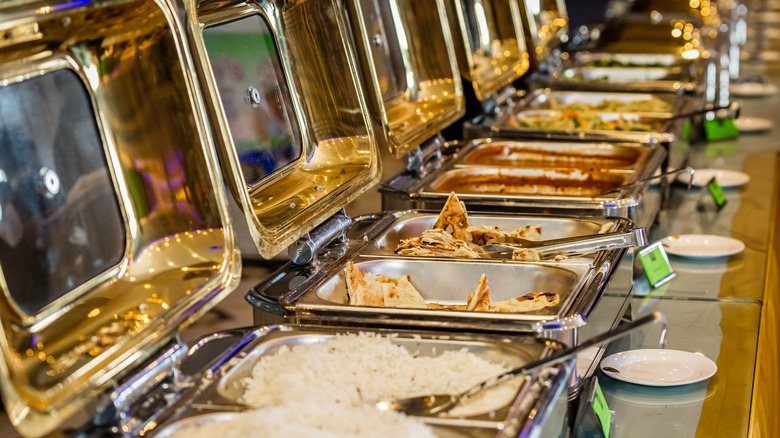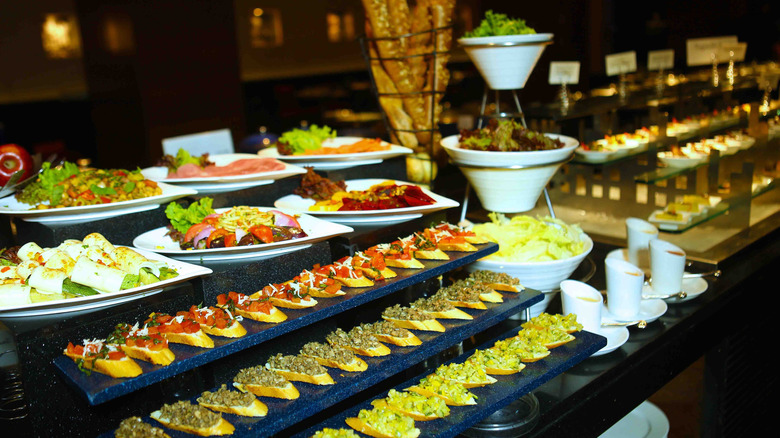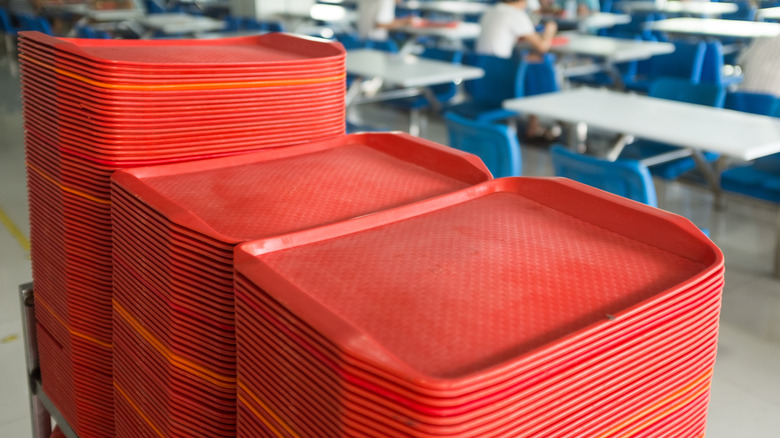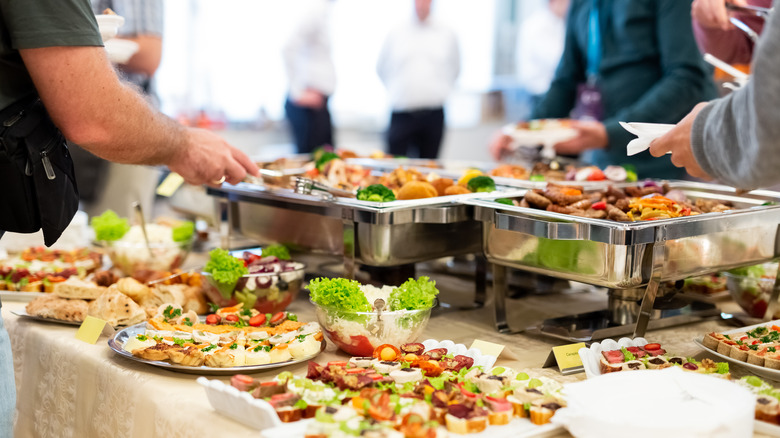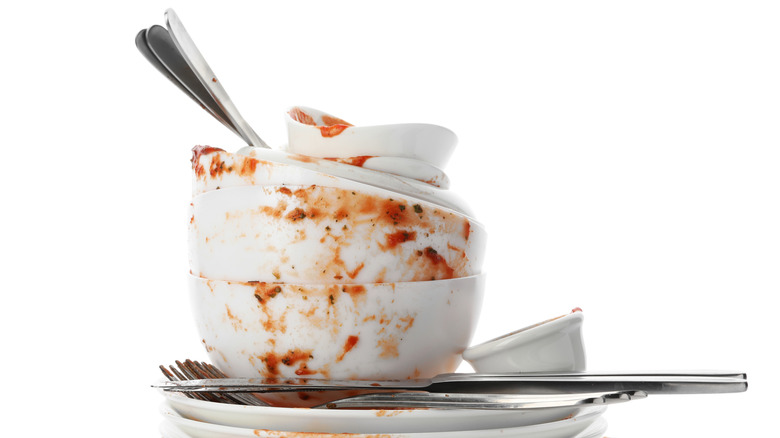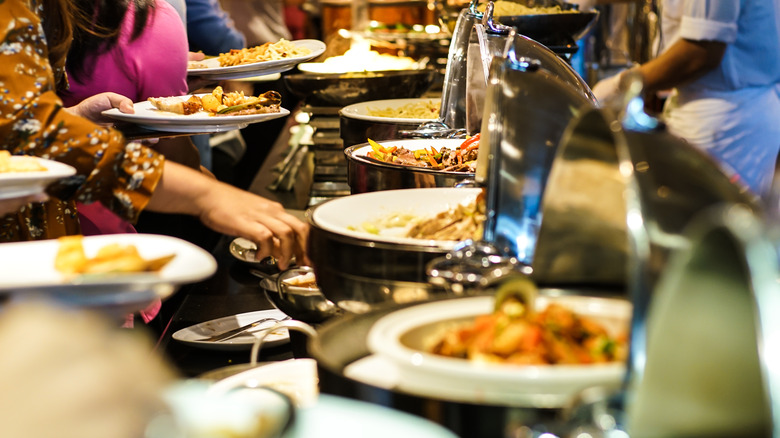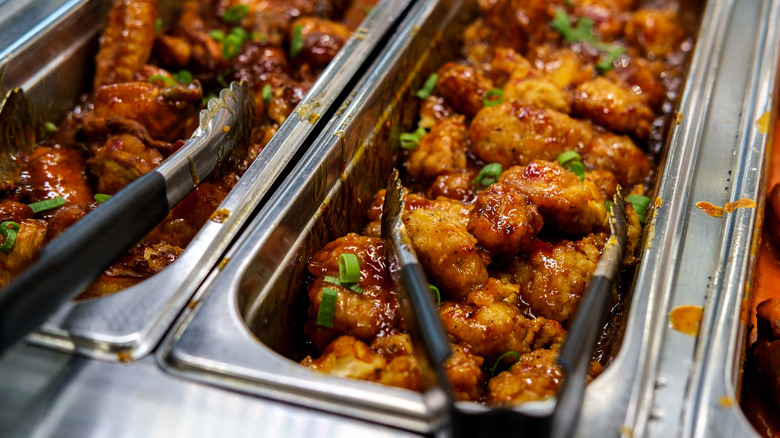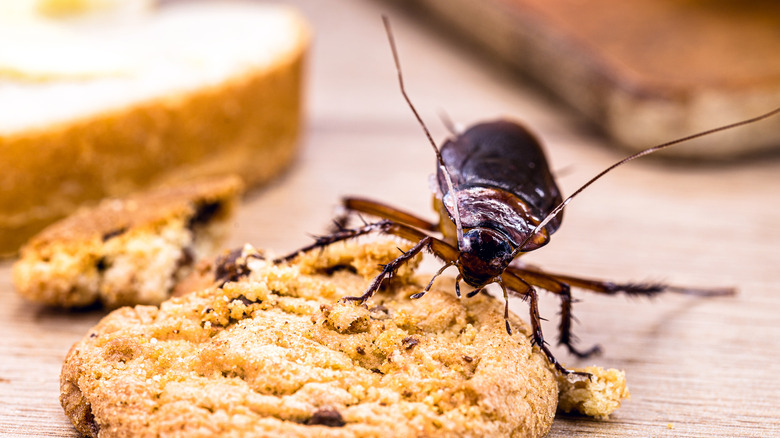Gross Things You Never Knew About Eating At A Buffet
Think dining at a buffet is a good deal? Think again. On the surface, buffet restaurants seem like a steal. You can eat as much as you want — and whatever you want — for one low price. Who doesn't love stuffing themselves silly with a little of this and a little of that? Omelet? Check. Steak? Sure. A couple of slices of cake with a side of chow mein? Why the heck not? No one's stopping you, but the reality is less than mouth-watering.
When you eat a buffet, you're eating at your own risk. We're not talking about the small chance that the dining room will erupt into a full-fledged fistfight over a steak shortage (like the Golden Corral incident that grabbed headlines in February 2022). We're talking about germs. As it turns out, there's a whole host of ways buffets can make you sick, and the novel coronavirus pandemic has only made it more complicated.
In 2021, Today questioned whether the pandemic marked the end of buffet-style dining. Though research has shown that the virus doesn't primarily spread through surface contact, there are still plenty of opportunities to pick up something nasty if proper health and safety protocols fail. On TikTok, gross buffet experiences seem like a dime a dozen. It all begs the question: even if you don't get sick, is it worth it?
Before you pile up the plates, here's what you should know. Sorry in advance!
Food sits out for hours
When you first enter the buffet line all you're probably thinking about is where to start. Should you go with the salad or head straight for the prime rib? What you're probably not thinking about as you start piling food onto your plate is how long it's been sitting out. This, however, should be the first concern.
Per Vice, it's not uncommon for a buffet to let food sit out for an hour or more. To avoid this problem, arrive at the buffet when they first open. This ensures that what you are eating is as fresh as the buffet has to offer (unless, of course, it's last night's leftovers). Also on that note, you should be wary of an empty buffet — unless, of course, it just opened (via Eat This, Not That!). An empty buffet may sound like a food lover's dream, giving you access to as much food as you want without a long line to stop you, but an empty buffet could be a warning sign. More people at a buffet means they have to replace the food sitting out with fresh food more frequently. Without a steady flow of people, there's no telling how long the food has been sitting there.
There's bacteria lurking in your food
One of the best things about buffets are the deals, but those deals can come at a price — and we're not talking about money. While the buffet may make it possible for you to gorge on pricey menu items like lobster, it also increases the possibility of food poisoning. Let's just say, there's a reason you should absolutely never touch the fish at a buffet.
When food isn't kept at the proper temperature, it grows pathogenic bacteria like salmonella and staphylococcus — and you can't smell or taste the problem like you would with spoiled milk. According to the USDA, all it takes is around two hours at room temperature for the bad stuff to brew to levels that could make you sick. Food in the danger zone (between 40 degrees and 140 degrees Fahrenheit) can see bacteria levels double in just 20 minutes. That's a whole lot of yuck.
Buffets do have a line of defense that aims to keep food at safe temperatures. Hot food items are placed under heating lamps and cold food items are left on ice. The problem is, maintaining temperature isn't easy. If those heat lamps and ice trays don't work as they should, you could wind up being one of the thousands of Americans that get food poisoning in a year (via Vice).
Those plastic serving trays are germ factories
Do you ever wonder how clean those plastic cafeteria-style trays really are at a buffet? Probably not clean at all. A porous surface like plastic is the ideal breeding ground for bacteria. While bacteria are everywhere, those plastic trays are considered to be one of the germiest surfaces you'll come across in public. So, just how germy are we talking?
The National Sanitation Foundation conducted a study to determine the most germ-riddled public places, during which researchers swabbed 26 different sources for bacteria species like E. coli and salmonella. Next to a park sandbox, restaurant trays came out on top (if private places were also surveyed, kitchen sponges would have probably been pretty high up there, too).
This is one of those weird issues the coronavirus pandemic may have actually improved, however slightly. The CDC now encourages communal dining facilities to put out hand sanitizer near dining room entrances so patrons can wash up before grabbing trays (which cuts down on the bacteria that are transferred from person to person). Buffets have also upped their sanitization practices (via Today). Even if the buffet you frequent is particularly lax, this is a problem a few anti-bacterial wipes can solve. It's better to be safe than sorry.
Other customers may have touched your food
An aging raw bar that's been left out for hours is gross, but humans can be a whole different level of disgusting. Don't take it personally; a buffet has the tendency to bring out our worst hygiene habits. For one, it's hard to keep track of children. One poster on Quora waxed unpoetic about a child left unattended at a buffet who touched the ice cream machine with snot-covered fingers. It's safe to say that they were probably not the first kid to get bodily fluids on a buffet spread.
It's not just kids that are bad. It's adults, too. Surveys have shown that only about 66% of Americans actually wash their hands after using the bathroom (via PR Newswire). A further 70% admitted to washing their hands with water, not soap — which won't get rid of fecal bacteria.
Luckily, in recent years, some buffets have adopted better hygiene practices in light of the pandemic. The CDC recommends nixing self-service (those tongs are a breeding ground for viruses and bacteria) in favor of individually plated meals. According to Today, Golden Corral even started serving its dishes "cafeteria-style" using "gloved and masked co-workers" to serve guests, along with putting up plastic barriers to block sneezes and coughs. Similarly, Whole Foods swapped out certain self-serve options with staff service at some locations.
There are dirty dishes left out on purpose
Have you ever noticed the mess of dirty dishes that pile up on buffet tables? It's easy to assume those dirty dishes are stacking up because the staff either doesn't care or doesn't have enough time to keep up with the hoards of gluttonous eaters. The truth of the matter is, the buffet may actually want those dishes to stack up.
It sounds like a poor business model because a dirty eating area is less likely to draw in customers, but that's kind of the point. According to AOL, a survey found that if dirty dishes are left at a patron's table, they are less likely to go back for more food. For a buffet, that's a bonus. By leaving the used dishes where they are, you consume less, meaning the buffet saves money. Buffets also design some of the furniture to be uncomfortable to discourage lingering. If you're looking to make the most out of your experience, request a table to be bussed or move to a new table altogether. You could also bring a comfy seat cushion. You may draw a few weird looks, but hey it's an all-you-can-eat buffet, you want to get your money's worth.
Cross-contamination happens
Don't be fooled: Just because each food item is placed in a separate serving container doesn't mean cross-contamination won't happen. With various food items in close proximity, it's not beyond a patron to dribble bits of food into other containers or swap the tongs from another dish. While that may taste unpleasant, it also has the potential to make you sick if you have a food allergy.
This is not something to be taken lightly. According to the International Association for Food Protection, about 15 million Americans have a food allergy — the most common being milk, peanuts, soy, eggs, fish, shellfish, tree nuts, and wheat. For those with allergies, consuming even the smallest amount of food can cause an instant reaction such as a rash or stomach discomfort. In the worst-case scenario, a severe life-threatening reaction such as anaphylactic shock can occur. With the self-serve style enabling everyone to have access to your food, there's no telling what food has been cross-contaminated. If you do have a food allergy, it may be a good idea to skip the buffet and look for a restaurant that can adhere to your dietary restrictions.
It's best to skip lemon in your drink
Do you prefer a fresh citrusy wedge of lemon in your beverage? I hate to break it to you, but you may want to skip that wedge because it is most likely contaminated. According to HuffPost, researchers discovered that some of the lemons used as a garnish in restaurant drinks were contaminated with bacteria that could possibly lead to illness. One such study found that half of the lemon wedges that were sampled contained human fecal matter. Another study found that out of 76 lemons sampled from 21 different restaurants, 70 percent of the lemon rinds contained microorganisms. Not exactly appetizing.
Researchers believe the contamination may be from not washing the fruits properly, or from restaurant workers or other customers touching them with dirty hands — especially if they're just sitting out on a buffet table. Although your chances of getting sick may be relatively small, it's best to play it safe and ditch the fruit. Or bring your own pre-washed lemon wedges from home instead.
Is that salad really fresh?
Buffets are great for so-called bad food (like the delicious fried foods that have nutritionists clutching their pearls) — but what about those who are health conscious? Sorry to break it to you, but you should steer clear of the buffet salad bar. A little heartburn is a lot better than a foodborne illness.
A 1999 report from The New York Times found that the food in a salad bar is often food that was left out, stored in the refrigerator overnight, and put back the next day. Even if the food was actually fresh, employees sometimes didn't wash the containers. They simply refilled them, mixing the old food with the new food.
Of course, we'd be remiss not to mention that buffet hygiene has improved over the course of the coronavirus pandemic. It's not the same as it was more than 20 years ago, and many buffet-style restaurants have put a major emphasis on sanitization (via HuffPost). That doesn't mean the salad is totally safe. Fresh produce and sliced fruit can harbor pathogens because they aren't cooked. You can take steps to reduce your risk at home, but eating raw produce at restaurants is inherently risky.
Everyone touched those tongs you're grabbing
The very thing meant to limit bacteria from making its way into your food could possibly be the biggest germ vector of them all. According to Food Safety News, it's a requirement that any serving utensil in food preparation be replaced every four hours. If a serving utensil falls into the food, the entire dish has to be discarded. Unfortunately, these regulations don't take into consideration public handling. How many times have you seen a spoon slip into a tray while an overworked employee had their back turned? It happens, and it basically means that everyone who touched that spoon before you did now touched your food.
Thankfully, some buffets are better than others. Many all-you-can-eat restaurants have nixed self-service in the wake of coronavirus. Even if they didn't, buffets aren't short of options. Stick to items doled out by staff and skip the items you have to spoon yourself (unless, of course, you get there when it opens).
The people preparing your food may be sick
The restaurant industry was hit particularly hard by the COVID-19 pandemic. It wasn't just indoor dining restrictions and closures that impacted eateries. Restaurants, already understaffed, had to deal with an onslaught of sick workers. As Wine Enthusiast reported, restaurant cooks were more at risk than almost any other type of worker during the first months of the pandemic. What's a buffet to do when half of its staff is ill? In some cases, the answer is to make them keep working.
Many restaurant employees don't get paid sick leave. It's no longer a federal requirement per the Families First Coronavirus Response Act. That means a whole lot of employees are coming to work sick — and they're handling your food and breathing your air.
According to a 2022 Business Insider report, 63% of Red Lobster employees who got sick still went to work, even though it's against the chain's rules. Two-thirds of those employees blamed a lack of paid sick leave. Though Red Lobster isn't exactly a buffet (even though its nearly bankrupted itself with an endless snow crab promotion), its employee policies are not unique within the restaurant industry, including buffets.
Rodent and roach infestations do happen
Would you eat at a buffet if you knew it was infested with rodents and roaches? Probably not. But buffets do experience infestations from time to time, and the patrons probably won't even know until a food inspector finds the problem. Every now and then, a buffet makes the headlines for unsanitary practices that cause a mandatory shutdown — not really surprising when you think about it, given all the food that sits out all day.
One such incident happened at a Golden Corral. According to ABC News, a Golden Corral in Florida was closed for 24 hours after a health inspector found over 100 rodent droppings at several food stations throughout the dining area along with other health violations. Another buffet was guilty of having live and dead roaches present in the restaurant. That doesn't exactly sound appealing. The scary part is that the health inspector may not always be lurking around when an infestation violation strikes. While your favorite buffet may be critter-free, there's really no telling what violations are occurring without your knowledge.
How much can you social distance at buffet?
You know those tiny, crowded restaurants where you can't ever seem to get a table without a 45 minute wait? They're trendy, but the coronavirus pandemic has made us rethink how we feel about cramped spaces.
The truth is, when you're at a buffet with other diners all fighting for a spot to fill your plates, you're breathing the same air — and ventilation has a huge impact on the spread of the novel coronavirus. One outbreak in China was associated with a restaurant's air conditioning, and entire eateries in New York City have had to temporarily shut down because too many workers contracted the virus. On top of that, certain anti-COVID measures that are meant to keep us safe (like those plastic barriers you see set up between tables) may actually make things worse, according to The New York Times.
To help mitigate the risk, the CDC recommends that restaurants improve their ventilation and increase airflow from outside through measures like opening windows and upgrading HVAC system filtration. They also recommend that patrons wear masks when they're not seated, but not every state has a mask mandate. Some restaurants have set up social distancing measures, but those only help if people agree to follow them (via Today). How diners behave is always a toss-up.
